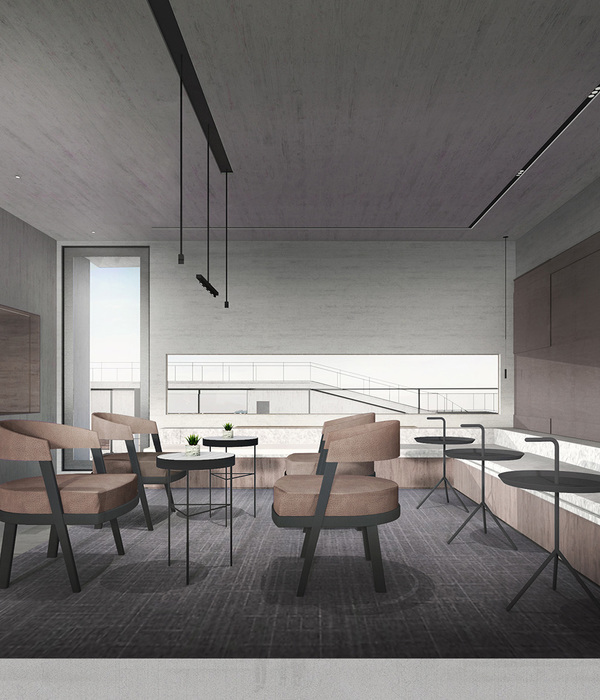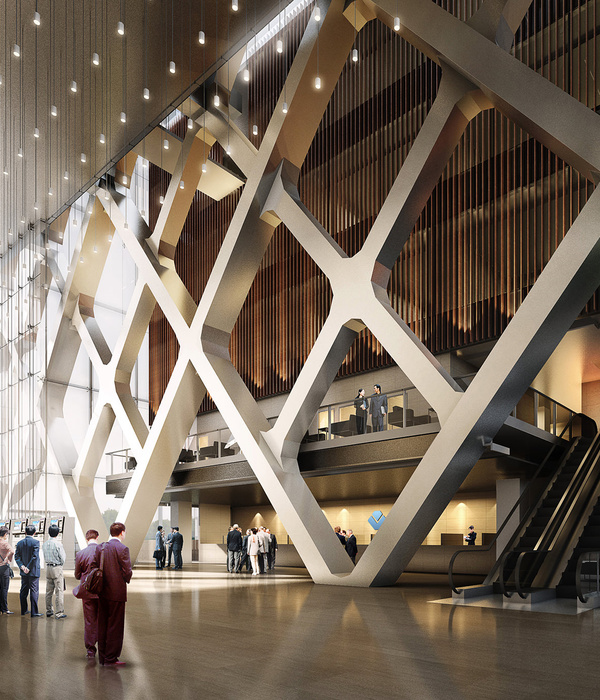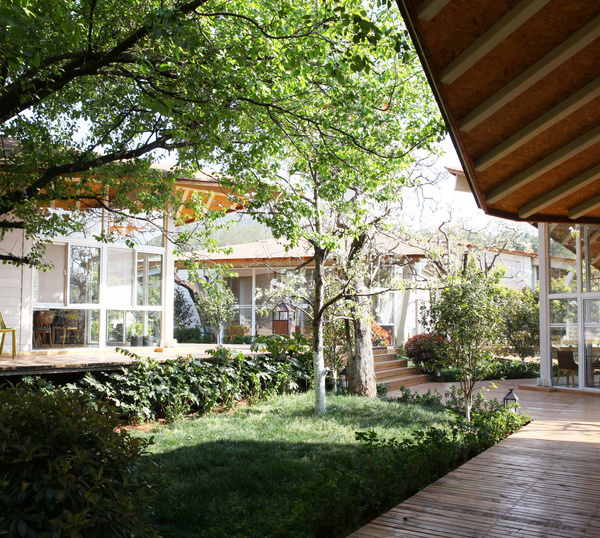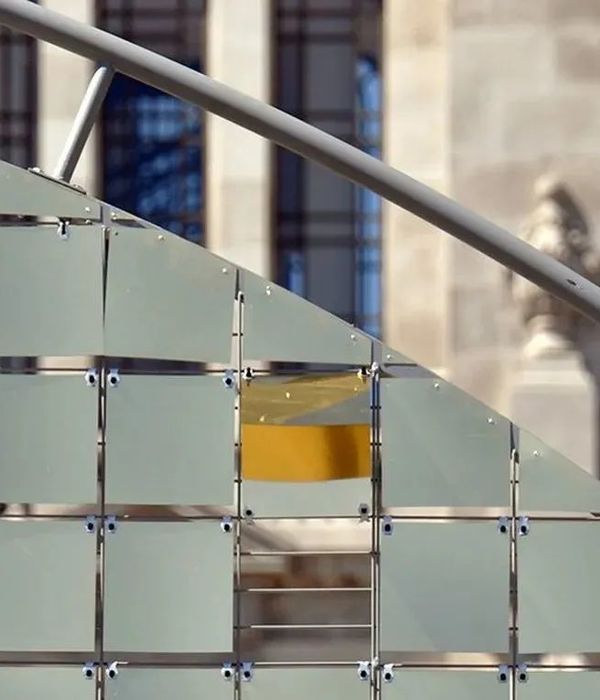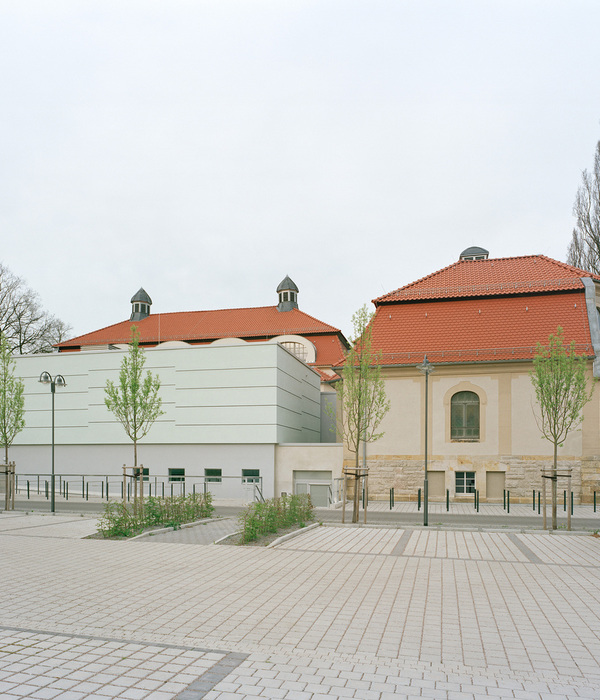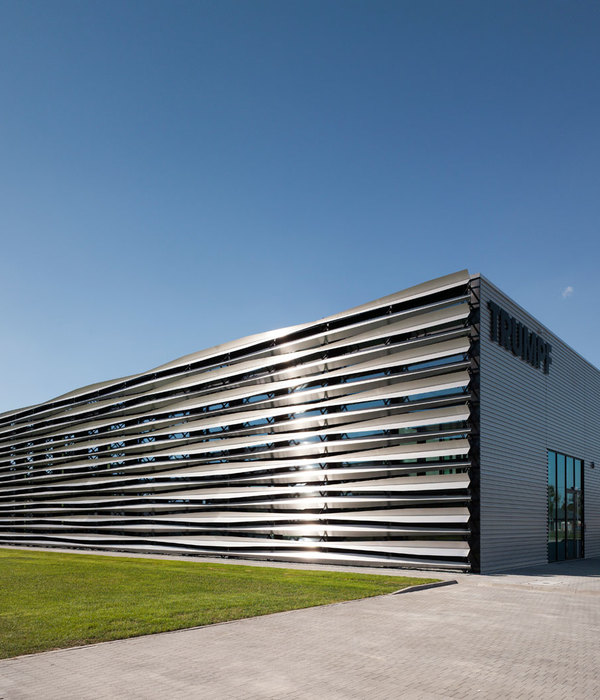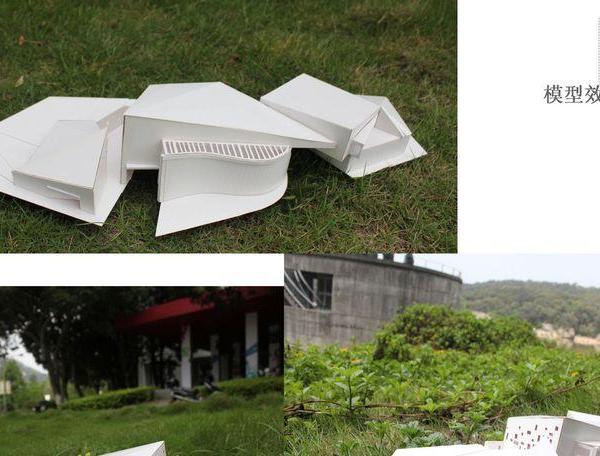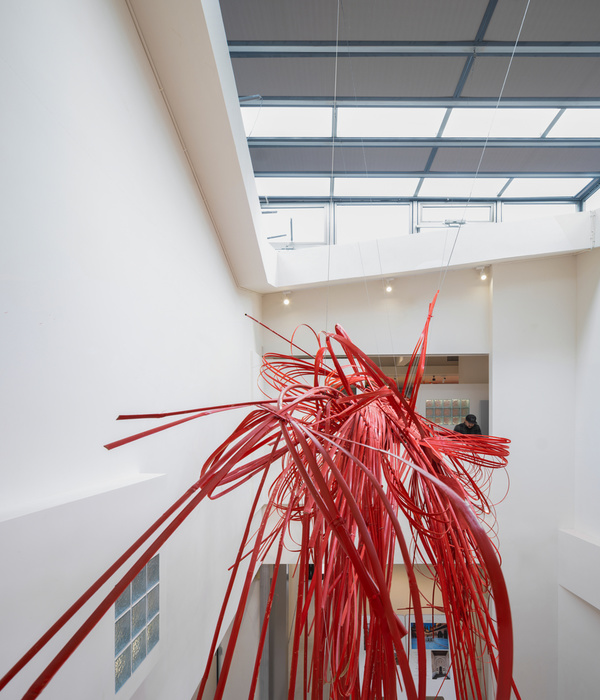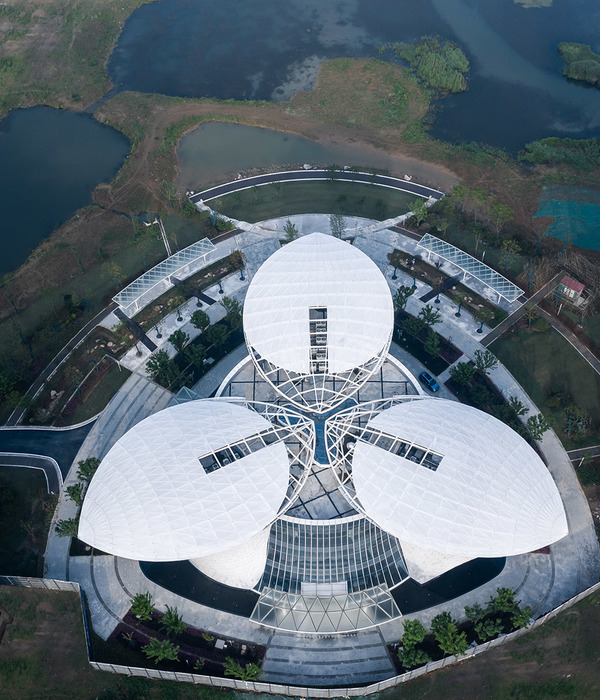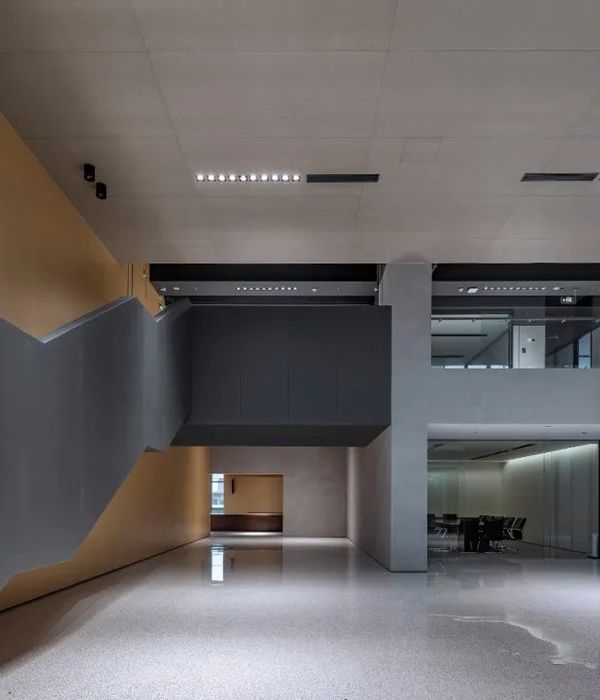- 项目名称:苏州科技城实验小学
- 主持建筑师:张 斌,Atelier Z+,LI Shuo,D-plus Studio
- 项目建筑师:陈颢(方案 + 扩初),丁心慧(竞赛)
- 设计团队:吴人洁,张金霞,谢林波,徐家金
- 合作设计:中铁工程设计院有限公司
- 建设地点:江苏省苏州高新技术产业开发区科技城科业路88号
- 建设单位:苏州科技城社会事业服务中心
- 基地面积:43880m2
- 建筑面积:53422m2
- 工程造价:2.5亿元人民币
所有的大人当初都是孩子——《小王子》安托万·德圣埃克絮佩里
也许改变这个世界面貌的不是我们,而是孩子,他们将是未来伊甸园的园丁,有着初芽般,能够穿透成人世界物质外壳的原初力量。为了打破快速建造的通属空间带给学生的过度规训与监护,我们试图以空间为媒介,在城市与自然的交汇处建立一个属于他们的田园绿洲。
It’s not us who will change the future of society, but children, who will be the gardeners of the future Eden, with the initial power of penetrating through the material of outer shell of the adult world. In order to break through the standardization and tutelage for students in the context of large scale and quick construction, we’re trying to establish a oasis for them at the edge of city and nature through the means of architecture.
▼项目概览,project overview
在追求效率、管控、与安全的国内基础教育模式中,虽然也开始逐渐重视学生成长中的社会性、创造性、与自主性,但是这些新的教育理念在通常条件的学校设计中往往很难在空间上得到切实回应。通常的用地标准、建设指标、与使用模式所导致的还是讲求效率、管控、与安全的空间样式,比如,过于明确的功能分区与固定的使用方式,过于均质的空间分配与单一的流线组织,这样的标准空间特别对于小学生来说更是缺乏启发与想象力的。而在苏州科技城实验小学的设计中,应为特殊的场地条件与任务要求,那些标准的空间模式反而无法实现,这使我们在保证基本的空间规范性之外,有机会去尝试对于孩子们的成长来说更有启发性的那些空间特质。也许改变这个世界面貌的不是我们,而是孩子。他们有着初芽般的、能够穿透石头、穿透钢筋水泥也要破土生长的力量。只有借用他们这股最原初的力量,才能打破快速建造的通属空间带给学生们的过度规训与监护,以空间为媒介,坚守我们对城市对山水田园的最初印象。
Under a highly governed, efficiently calibrated and safely implemented pedagogical system of China, the social and creative aspects in education are rising in their importance. Yet these emergent ideas in recent educational trends are difficult to be exemplified in architectural terms. More often, the land use plan, zoning regulations and programmatic uses are redirecting back to a highly efficient way of designing. For example, a highly distinct segregation of different functions and inflexible configuration which discourages inventive uses are homogenising the spatial arrangement and creating monotony in circulation and flow. This standardised space does not make any room to instigate an inspiring environment for junior grade students to develop their imaginative thinking. In our design for the Suzhou experimental primary school, we have tailored a response to the cope with the distinct site condition and the requirement of the project brief. Ironically, the constraints that we have do not drive us to a conventional standardised design, but instead allow us to develop spaces that profoundly inspire the children throughout times. We have a strong conviction that the future lies in the hand of our younger generations but not us. The power of youth is immensely robust that no physical substance on planet earth could constrain or bound it. For us as architect, we utilise these momenta from the younger generation to resist the status quo and adapt the reality.
▼校园鸟瞰,aerial view
苏州科技城,如同其他高歌猛进发展中的城市新区一样,为了适应当代城市高效运转的要求,将土地分割成尺度相近,属性不同的网格。苏州科技城实验小学用地则是在这种状况下对宏大的自然地貌做出避让后的极端体现——处于紧张的城市网格与舒缓的自然地貌的临界状态。场地一侧是视线舒缓且承载自然与记忆的河道、湿地、山体,而另一侧则是近乎数学公式计算出一般的高密度高层人才公寓。这仅存的尚未被“侵占”的柔软自然界面,呼唤着我们心底关乎童年关乎小学的记忆。这种关乎场地与时光的特定记忆,是当今拷贝的户型、等距的空间、合乎规范的退界,以及“计算”出的日照所不能设计出的空间氛围,甚至可以说那种刻意与刻板的设计观与我们所向往的世界观是对立的。
The Suzhou technology and science town share similar characteristics like other new intensely developing towns. The city planning adopts a highly efficient model where the land is subdivided into a grid of various natures with similar urban scales. Our proposal here takes advantage of the existing constraints and leverages the maximum value from the natural surroundings – Confronting both the tight city grid and the grand nature nearby, one side of the site is edged by the lush nature such as canals, wetlands and mountains. The opposite edge of the site is facing a highly artificial environment filled with high density apartment towers.To us, the site demonstrates a uniquely ‘soft’ interface with nature that remains intact. The serenity that the site exhibits remind us the connection to the childhood memory of what a primary school should be. The marriage of the specificity of the site and our past memory offers a unique relationship between space and time. The culmination of the given condition and our perception negates the notorious mentality of development in China in which repetitive efficiency, homogenous layout and code compliant design take charge of the project. Towards the existing monotonous way of operating in the industry, we are rebellious to the norm and trying to subvert the condition through our design.
relationship between city and natural environment
面对这一紧凑的场地条件,复杂的周边环境,以及高强度、高密度的容量要求(容积率 1.5),我们要做的则是在这些表面上对立的元素之间,寻找到融合的平衡点。本项目基于场地两侧城市的建成景观与自然景观的巨大差异而产生的对抗性,以及社会普遍存在的对当代应试教育模式常态存在的抗争性,这些矛盾决定了场地内建筑肌理本身便存在了自我的抗争与适应。我们对项目的首要思考便是发掘这些存在对抗性的因素,从空间和情境的多元化入手,去探寻其内涵的适应性。我们通过对全方位的综合素质提高的探讨,使设计实践的社会责任感与教育意义在该小学中得以提升。
校园与城市,the school campus in its urban context
苏州是拥有数千年建城史、承载中国文明传承的古老城市,是中国首批 24 座国家历史文化名城之一。在农耕文明时代,这里就曾出现过 54 位文状元,6 位武状元,居全国出状元地区之首。近代工业时期,苏州籍的两院院士数量也居全国之最。生活在快速发展的城市中,我们已然对城市、历史的认知产生了断层。如何使苏州这一座城的历史、山水、人文能在位于苏州西部经济高速发展的科技城中体现,如何使这所学校的孩子在受教育的同时对历史以及时代的认知尽可能完善,是我们在探讨设计之余当仁不让的职业素养与社会责任。
With thousands of years of rich history, the old Suzhou Town is one of the 24 renowned historical cities while being a condenser for traditional Chinese civilisations. In the agrarian era, Suzhou is the number one famous birthplace for many elites and scholars. During the industrial Age, the number of influential academicians who came from Suzhou far exceeded anywhere else. Living in contemporary times, our generation gradually loses a recognition towards the history of our city and culture. Our mission here far exceeds our usual professional responsibilities and ethics. We pay effort to bridge the connection between the history, nature and culture with the developing western high-tech zone in Suzhou. Taking the opportunity of designing a school, we also aspire to re-connect the education of the younger generation with the historical context and the legacy of the contemporary era.
▼南侧入口视角,view to the entrance facade
传统书院不仅是具有知识传授功能的场所,更是文化传播形式与载体演变的历史见证。最早的书院出现在唐朝,是古代民间的教育组织,原由富室、学者自行筹款,在山林僻静之处建立。在苏州,从宋代的和靖书院,到元代的文正书院再到明代的碧山书院,直至近代,苏州书院的数量之多,密度之大,足以傲视全国。
如何将苏州传统的书院文化和当代教育理念相结合,是苏州科技城实验小学设计的思考起点。当代的基础教育一直是在探讨如何提高学生全方位的综合素质的争议中演进。一方面要保证学生有效的足量的知识摄取。另一方面,又希望学校模拟的微型社会环境,可以弥补学生在家庭中社会性教育的不足。我们据此提出了一个更为积极和谐的“垂直书院”系统,对传统书院模式进行延续与再造。
The traditional academy is not only a place for knowledge, but also as a physical presence which witnesses our evolution in history and transmission of culture. The earliest form of academy as a non-governmental format was originated from Tang Dynasty. While the privileged and the scholar initiated the fund-raising for constructing small schools in the serene hillside. Starting from the He Jing Academy of Song Dynasty, the Wen Zheng Academy of Yuan Dynasty, to the Bi Shan Academy of Ming Dynasty, Suzhou is the city where the density and quantity of educational facilities have been dominating the nation.
The design of Suzhou Experimental Primary School reinterprets an integration of traditional culture of Suzhou academies and contemporary ideals in education. While the contemporary education advocates the upbringing of all-rounded students with a commitment to introduce sufficient pedagogical knowledge, it also aims at simulating a miniature of society for nourishing the younger generations. We suggested a proactive yet harmonious vertical academy to reinvent the traditional typology of education architecture.
▼设计概念,design concept
在学校空间的设计上,我们从微观角度和宏观角度两方面切入,希望这个“垂直书院”不仅能够在各个空间功能、形态和氛围上满足使用者,同时能够生成和谐的肌理,并融入城市之中。首先,我们将学校的功能作了区分和组合。把用于普通教学的标准化教室,以效率最大化并满足间距要求的原则,组合成三个相对独立的教学院落,每个教室都在一个阵列式的网格体系里,布置在基地西侧靠近城市界面一侧,满足基本的教学需求。这样,对城市密集一侧形成较为严整、内向的态度,以内庭院的形式隔离出相对于外部高楼林立的新城肌理下的一方净土。同时,把教师办公和行政管理、讲堂、图书馆和合班选课教室、风雨操场和食堂等对于面积,形态,体量要求各不相同的功能,以分组退台跌落的方式组织起来,由南向北分四组布置在基地东侧靠近自然界面一侧,层层退台面向基地东侧的山体。
▼功能图解,programme
While having both a macroscopic and microscopic frame of references, the ‘vertical academy’ not only intends to cope with the user’s experience in terms of program, form and ambience, but also establishing a harmonious relationship with the city fabric. Grouping and categorizing various functions of the school, we form 3 rather distinct courtyards by clustering standardised classroom units. These standardised units require a maximisation of efficiency in layout with sufficient separation between them. Within an autonomy of grid system, every classroom fulfilling the basic educational purposes is located on the western edge of the site with an interface juxtaposing the city. The introvert and ordered nature of this configuration defines an idiosyncratic character facing towards the city’s urban fabric. These courtyards form an urban oasis within the neighbouring clusters of high-rises in the new town. Also the offices for teaching staff, administration, auditorium, library, classrooms for elective courses, outdoor playground and canteen all have different area, form and massing requirements. A terracing form creates setbacks and creates groupings of multiple functions, which is arranged along the eastern edge nearby nature. The terraces form 4 groups from south to north and face the eastern mountains acting as an architectural response.
▼空间轴测:教学空间被组合成三个相对独立的院落,axon: 3individual courtyards are formed by clustering standardized classroom units
户外运动场也布置在基地东侧,与建筑的退台肌理相呼应。这种基于情感层面的操作方式将建筑界面的完整性打破,自然地流露出向自然延展的热情与态度,更是对自然景观的一种尊重的表达。其次,我们通过一个脊椎状的公共空间系统,将东西两侧氛围不同的空间串联起来。它既是连接整个学校南北向功能的必要通道,也是东西两侧标准教学功能和交流体验功能转换过度的空间,严整的院落与水平生长的退台在这里进行了一次和谐的对话。这一公共空间系统由南往北逐次由宽收窄。
东侧操场视角,view to the playground on the east of the site
▼运动场也与建筑的退台肌理相呼应,the outdoor playground is situated on the east of the site establishing an interesting dialogue with the setbacks of the architecture
最南侧由学校主入口进来是一个四层通高、带有充足高侧顶光的开放式入口中庭,并有大台阶把师生直接引向二层。入口中庭北侧是和讲堂的地形变化相延续的、带有不规则分布的园型天窗的多功能半室外剧场,是激发师生自主交流活动的空间装置。再往北侧则是一段宽大的多层连廊联系东西两侧。
▼入口剖透视图,sectional perspective of the entrance area
While the communal spine tapers down from the south to the north, the main entrance is located at the southern side defined by a 4-story tall atrium with an abundance of natural light. Grand stairs institutionalise the act of entering the school and lead people up to the second story. The north of the entry atrium is a formal extension of the topographical change of the auditorium and possesses a semi-outdoor theatre which features punctures of irregular skylights. All these spatial settings instigate a milieu for a constructive dialogue between the students and teachers. Towards the northern end, there is a multi-layered system of spacious footbridges connecting the spaces along the east-west direction.
南侧主入口,main entrance
四层通高、带有充足高侧顶光的开放式入口中庭,the main entrance is located at the southern side defined by a 4-story tall atrium with an abundance of natural light
▼入口大台阶,the grand stair
南北走廊,the south-north corridor
▼多功能半室外剧场,the multi-functional theater
在与历史文脉、城市发展、教育思考、以及童年记忆的一次次对谈之后,最终,我们在这样一个用地紧张的基地上,通过高密度的水平与垂直相结合的空间模式,构建了一个亲近自然的多层次的交往空间,提供了一系列灵活多变的教学场所,鼓励学生在此漫步、玩耍、相遇,相对于国内通用的教育空间模式,这样的处理更易于激活并形成多样的教学方式,同时其公共属性也有益于培养学生的社会能力。
园林般的空间体验延续了这个城市的文脉,而将其在竖向叠加的做法有效地解决了本项目校园活动空间不足的缺陷,形成了一个垂直的书院。
Creating a dialogue between the historical context, urban development, pedagogical ideas, and childhood memory, we manage to a compact spatial arrangement which integrates the horizontal and vertical dimensions within a tight site. With an intimate connection with nature, the multi-layered spaces offer flexible and diversified teaching spaces which encourage student’s activities such as meandering through, playing around and bumping into one another. In contrast to the traditional education spaces, our attempt activates and diversifies different formats of teaching. The public nature also nourishes a socially viable atmosphere for students to interact. The garden-like spaces respond to the traditional city fabric of Suzhou, and the stacking which forms the vertical academy efficiently tackles the challenge of having a lack of space in the site.
▼建筑东北角,view from the northeast
一层平台,F1 platform
▼二层平台,F2 platform
▼水平与垂直相结合的空间模式,the multi-layeredspatial experience
两千年前孔老夫子的“习礼大树下,授课杏林旁”,为我们生动地描绘了一幅以自然为课堂、在大自然中读经诵典的理想场景。为了提供给成长中的孩子们一个多样性的活动空间与交往空间,让孩子们在学习中成长,我们在临近城市的一侧置入内部庭院,在面朝自然的一侧延展出外部立体园林,二者共同构建出亲近自然、空间层次活泼多样的小学校园内外环境。提高空间使用效率的同时,也使得自主学习成为一种富有乐趣的校园生活方式。内与外、大小不同的院落的堆叠使建筑在内部具有了聚落一般的感受,建筑不再是单一的个体存在,而是为了孩子的生活而存在的教学与玩耍功能复合的“综合体”。
▼由天窗照亮的图书馆,library with large skylights
内庭院是具有中国传统意义的最常见的一种院落形式,四周封闭而向天空敞开的强烈的庇护感为孩子们开辟出一方湛蓝的天空,像是在局促的城市中挖出的一眼清泉,映出孩子们眼中的的清澈。内庭院空间具有强烈的垂直指向性,有效地避让了周边建设中的嘈杂的城市不利因素,渲染出了校园本该拥有的安静、纯真的环境气质。在放学或者阳光正好的午后,在院子中边玩耍边做作业,抬头望向那四角的天空,如同曾经在宅院中那四方天井下的记忆。
The courtyard carries a symbolic meaning in traditional Chinese architecture. While confining 4 sides with views opened up to the sky, children take ownership of the serene oasis within the densely compacted city. While the courtyard has a strong sense of verticality, it is effective to fence off the undesirable hustle and bustle of the city and render an absolutely quiet environment for students to learn and think. The sunshine after school is also perfect for having leisure time or doing school work in the courtyard. The framing of the sky also resembles a collective memory of the domestic life in traditional courtyard housing.
▼内庭院空间有效地避让了周边建设中的嘈杂的城市不利因素,the courtyard is effective to fence off the undesirable hustle and bustle of the city and render an absolutely quiet environment for students to learn and think
错落有致且水平延展的退台是对江南园林空间的立体重构,通过垂直方向的共享空间的置入,以及面向自然景观的水平平台的延展,使得在土地是稀缺资源的高密度的大都市中,能够获得园林般的空间体验。
对于一个人的成长来说,童年更是最为宝贵的甚至影响一生的经历。科学实验证明,儿童的生活环境和学习习惯直接影响他们的行为和记忆能力。
空间的丰富性直接地刺激学童对立体空间的感知,丰富的景观视线关系在潜移默化中陶冶着性情,不经意间的视线交流促进着孩子之间的交流,各类课外活动内容的延伸丰富了“外园”平台的学习场所用途。
于是在不经意间,孩子们拥有了“大”自然。
▼错落有致的退台能够直接地刺激学童对立体空间的感知,the stimulations of a diversified spatial arrangement play a significant role on the 3-dimensional perception children have.
当今城市高密度的土地使用状态是当下社会普遍存在的问题,因此,在设计中如何高效地利用并合理地调配现状条件是能否为孩子们留出一片活动天地的关键。我们在设计中整体通过对一张一弛的把握,将学校的主要功能空间进行分类组合,为校园外部活动空间设计的多种可能提供了余地。校园整体上分为标准化的教学院落、社会交流性强的活动空间,以及作为“脊椎”的交通廊道三个部分。紧凑与松弛的对比,既是对城市的某种情感对抗,也是对自然的压抑已久的渴望。
The land use in the existing highly dense city is problematic. Our design leverages an efficient use of land while providing a paradise for children are a key to our success. We intentionally create alternating tensions within our design approach and categories various functions into groups. Leaving room for tackling challenges of the outdoor activity spaces, the educational courtyards, the socially vibrant activity spaces and the communal spine form the 3 main components of the design. Compact and loose arrangement of spaces form antagonistic tensions, in which confront the city with a sentiment and embrace nature with affinity.
▼平台流线示意,circulation diagram
教学功能单元紧凑集约布置,在满足规范的基础上,尽可能地留出场地,使得剩余空间具有更灵活的可操作性与可变性。建筑整体上向城市与自然两侧对立伸展,以运动场来衔接自然与建筑。作为“脊椎”的交通系统被频繁使用,在使用中新的路径将被探索,未定义的活动空间将被触发。这种路径是不能够被计算的,按照排列组合来说不同的路径有上百种,但属于每个人自己的路也许是独一无二的,如同霍格沃兹旋转跳跃的楼梯也许直到他们毕业的那一天,才会发现自己学校还可以这样走过。或许再过十年、五十年,他们重回母校,还是想要把未走过的路都走一遍吧。
The compact arrangement of the teaching units compiles with code requirements and leaves more room for flexibility and adaptability in the remaining spaces. The entire architecture extends to both the city and nature while the outdoor playground acts as an in-between mediator. The circulation spine is frequently in use while new paths and undefined activity spaces are yet to be explored by the users. The seemingly unplanned circulation or paths are part of a planned variety of over a hundred combinations. Like one of the dreamy settings in the Hogwarts House of the Harry Porter novel, students may get easily lost and constantly discover new spatial experiences till they graduate someday in the future. Whether be it 10 or 50 years, graduates may still have new perception about the spaces in their alma mater.
▼平台活动示意,activity on different levels
平台上的学生活动 – 老师拍摄,student activity on the platform – photo by the teacher
交通系统扩展并融入形态松散的一侧,这使房间的功能定义模糊化,使空间在使用上更具有生长性与可变性。正是因为孩子的强烈感知驱使,如触摸树叶,如在席地而坐观察昆虫,才让这些社交空间有了生命力,空间手法也不再是矫揉造作的纸上谈兵。它是在有限的场地空间中,为孩子们提供的无限可能。徜徉在花房、园林、景观活动平台之中,竟也暂时忘记了习以为常的拥堵交通与形色匆匆的日常。有张才有弛,这也许就是我们想要努力“挤”出的世外桃源般的存在。
▼张弛有度的空间布局,spatial arrangement balancing in tension and relaxation
孟子在《仁者爱人》中提到:君子所以异于常人者,以其存心也。君子以仁存心,以礼存心。国学中的仁者,指的是具有大智慧、人格魅力、善良的人,也应当是教育的育人准则。因此,作为以传道授业为职责的书院,责任不可谓不重。如同课业知识的积累一样,社交能力与人格养成也存在循序渐进式的发展,童年时期的片段式的记忆对性格的影响尤为重要。在应试教育繁重的课业模式下,将使学生无暇开展社交活动,过于单一和程式化的校园生活也无法刺激多样社交场景的产生,使得独生子女的成长方式趋于欠社会性发展。一些研究表明,各式各样的集体活动场所对孩子们建立和谐健康的关系起到关键的积极作用。因此我们希望,从“垂直书院”的设计之初,我们就能弥补应试教育的这一缺失,不仅为学生学习专业知识提供更加舒适的空间,更要为他们社交中仁爱、智慧的人格形成提供更多可能。
Meniscus advocated that a man with noble character exhibited benevolent quality. While these people often posses wit, charisma and kindheartedness, these qualities should be part of all the criteria for an all-rounded education. Preaching and teaching are the fundamental responsibility for an academy of this kind. More than just knowledge, social capabilities and nourishment of personalities should also be equally emphasised in developing the educational curriculum. In the nowadays exam-oriented mode of teaching, students often do not have much time for social activities. The homogenised school life makes no room for a diversified social opportunity. As a result, this is problematic to train up the social skills of the younger generations. While research has already proven that varieties of collective activity spaces exert positive impact on children for building up harmoniously a relationship with one another, we believe our vertical academy is a viable mean to supplement what existing educational spaces lack. Not only does our design leverage comfort and flexibility that works well with educational purpose, it also offers possibilities for student to socialise and gain wisdom from various forms other than books.
▼体育课上的孩子们,children at their physical class
在苏州科技城实验小学的校园设计中,学校公共性最强的功能单元被主要交通空间所围绕,这使得这些单元具有一定的必达性,激发空间的多义性与活动多样性,并促使每个学生都能有效地参与到多种活动当中。方案中注入的大量社会交往空间,满足了多种课外教学功能。学生对校园空间的利用率和空间的人气之间形成了积极影响,多样化的活动则形成了校园独特的人文景观。这便是我们希望看到的——学生不仅是校园的使用者,更加是校园中的一员,他们的活动、交流和欢声笑语成为了校园最核心、最动人的景观。此外,这些空间拥有多种进深和尺度、不同程度的私密性以及丰富的情感内涵,风雨操场和剧场以开敞的大空间,希望充分激发学生的创造力和想象力,图书馆则为学生提供了独处和交流的复合空间,让学生既能够在安静的环境中思考和阅读,又能够进行交流和碰撞,而当孩子们漫步、玩耍在错落的景观环境中的花草树木之中时,似乎就已经实现了 Kahn 所期望的能在树下教学的理想原型吧。
In the Suzhou Experimental Primary School, the social component is reinforced by a circulation space that wraps around it. This makes all the units accessible and triggers a variety of activities happening in these spaces. There is an abundant amount of social space introduced into the scheme. It not only fulfils the educational requirements, but also establishes a vibrancy within the campus. Our intention is not to see the student as mere users of the campus, but a part of the greater unity. Their activities and interactions are the core that become the most exciting moment in the design. Various depths and proportions of spaces allow a varying degree of privacy in space. The openness and flexibility of the outdoor playground and theatre serve as an important key to trigger student’s creativity and imagination both spatially and programmatically. The library provides spaces for solitude and gathering so that students could enjoy a moment of silence to read and think. Through the collision of different thoughts and ideas, children immerse themselves within an organic arrangement of garden settings. This also resembles a scene that Louis Kahn promoted: ‘Schools began with a man under a tree who did not know he was a teacher.’
▼体育场,gym
延续书院并不是初衷,退台错落也不是目的,我们想做的仅仅是为孩子们争取一份独特的童年经历。有时仅是树叶间透过的一缕光,有时仅是悄悄夹在书中的一片叶,今后都可能成为他们心底的柔软与善良。值得欣慰的是,在近期的回访当中,沿山体方向的平台已经被年轻的老师们赋予多个主题,诸如校园农场,开心集市,这些用途也帮助实现了设计的意义。多样开放的空间,让后续使用有着更多的可能性,伴随着时光而演变,伴随着童年而成长。当大片的土地被城市化的浪潮所裹挟的时候,我们也算为孩子们在这钢筋混凝土的洪流之中,营造出一方伴随他们成长记忆的模范自然的天地吧。
Our main intention is neither continuing the typology of the academy nor purposefully making organic courtyards and setbacks. We only want to strive for an opportunity to create a unique childhood memory for the younger generation. Memories are very personal indeed. Sometimes even light penetrating through the leaves or a leaf falling on a page of a book could be profoundly memorable which one would appreciate for their lifetime. In recent site visit, we are pleased to see that the podiums facing the mountains were designed to have themes by the young teachers there. Like the school farm or bazaar are all uses that the design leverages. We hope various open spaces would trigger possibilities that exceed our imagination and nourish the children with great memories to be remembered for life. In the process of urbanization, we felt tremendously fortunate to have constructed a concrete world for our children to live with and more importantly to dream on.
在钢筋混凝土的洪流之中营造一方充满成长记忆的天地,a concrete world for children to live with and more importantly to dream on
▼模型,model
▼轴测图,axon
叙事剖面 – 入口及表演空间,narrative section: entrance and performing spaces
叙事剖面 –图书馆及室外平台,narrative section: library and outdoor terraces
叙事剖面-- 操场及走廊台阶,narrative section: playground and corridors
▼总平面图,site plan
一层平面图,first floor plan
▼二层平面图,second floor plan
▼三层平面图,third floor plan
四层平面图,fourth floor plan
项目名称:苏州科技城实验小学
主持建筑师:张斌/致正建筑工作室++ 李硕/大正建筑事务所
项目建筑师:陈颢(方案++ 扩初)、丁心慧(竞赛)设计团队:吴人洁、张金霞、谢林波、徐家金
合作设计:中铁工程设计院有限公司
建设地点:江苏省苏州高新技术产业开发区科技城科业路 88 号
建设单位:苏州科技城社会事业服务中心
设计/建成:2013.06/2015.09
基地面积:43880m2
建筑面积:53422m2
工程造价:2.5 亿元人民币
摄 影 师:夏至、陈颢
Credits and Data Project Name: Experimental Primary School of Suzhou Science and Technology Town
Architects: ZHANG Bin / Atelier Z+, LI Shuo / D-plus Studio
Project Architect: CHEN Hao (Schematic Design & Developing Design), DING Xinhui (Compitition)Project Team: WU Renjie, ZHANG Jinxia, XIE Linbo, XU Jiajin
Design Cooperation: China Railway Engineering Design Institute Co., Ltd.
Location: 88 Keye Road, Science and Technology Town, National New and Hi-tech Industrial Development Zone, Suzhou, Jiangsu Province
Client: Social Programs Service Center of Suzhou Science and Technology Town
Time: Jun., 2013 – Sep., 2015
Site Area: 43880m2
Gross Floor Area: 53422m2
Cost: 250,000,000Yuan RMB
Photography: XIA Zhi , CHEN Hao
{{item.text_origin}}


